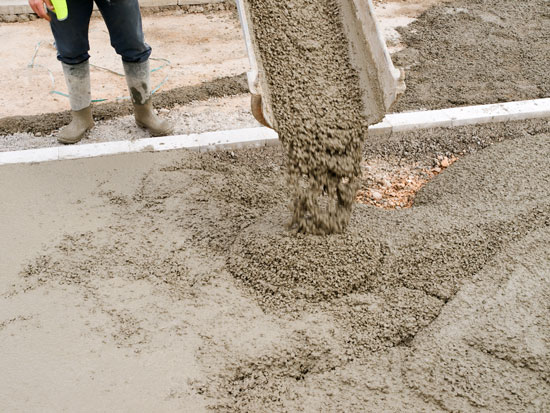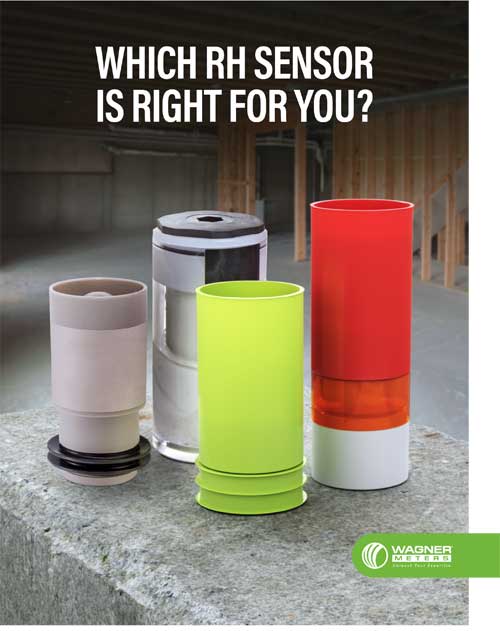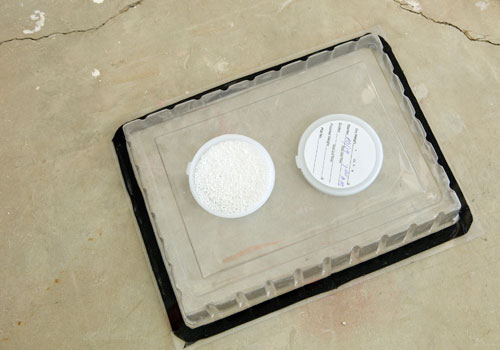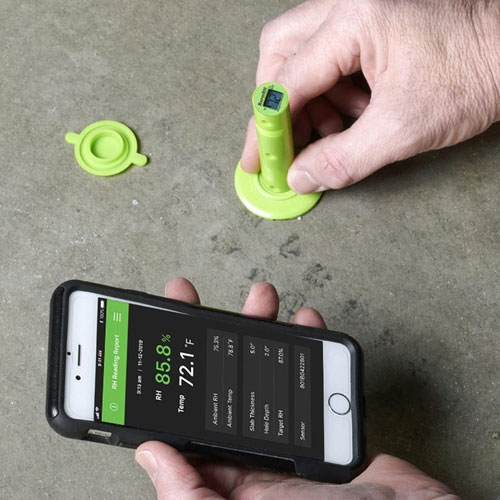Ensure that Your Safety Flooring Is Indeed Safe with Accurate RH Testing

Because freshly poured concrete contains a surprising amount of water, always test for moisture before installing safety flooring.
Previously published by Tomorrow’s Contract Floors Magazine
Without question, floors are one of the most important and extensively used elements in any building. Floors are subject to almost constant use and are often a contributing factor to accidents that lead to injury, slips, and trips.
When it comes to flooring, it always pays to give close attention to safety.
One way to help promote safety and prevent injury is to install safety flooring, sometimes referred to as non-slip flooring. Safety flooring is specially designed to minimize risk and provide safe movement in any high or low traffic areas that may be exposed to contaminants.
Is Safety Flooring Always Safe?
While safety flooring—by design—does a good job of addressing slipping hazards, do not assume that safety flooring is always safe. The fact is: it can easily succumb to significant safety issues such as blistering, cracking, buckling, and warping. All these conditions constitute significant tripping hazards. And these hazards may occur if insufficient attention is given to the moisture condition of the subfloor at the time the finished floor is installed.
Moisture in Concrete Subfloors
Concrete slabs are commonly used for subfloors, and all slabs contain substantial amounts of water—roughly 16 percent by volume. Indeed, without water, it is physically impossible for concrete to achieve its characteristic strength, hardness, and durability.
Even though a concrete slab may appear to have dried sufficiently for the finished floor to be installed, do not be fooled! Deep inside that supposedly dry slab, surprising amounts of moisture can still be found. If too little time is allowed for the concrete to dry to the level specified for the particular flooring product being installed, catastrophic damage could occur to the finished floor later on. Problems could show up days, months, or even years after installation. Conditions such as cracking, buckling, or warping may render “safety flooring” no longer safe or risk-free for use.
Remember the general rule of thumb for drying concrete: allow one month of drying for every inch of thickness.
How to Prevent Moisture-Related Problems
Fortunately, such problems are almost always preventable. The best means of ensuring successful flooring outcomes when working with concrete subfloors is to gain a good understanding of the moisture condition of the slab prior to the installation of the finished floor product.
The way to do this is to conduct an accurate test of slab moisture. Different methods of testing for moisture are available, however, not all test methods are equally accurate and reliable. Choosing the best test method depends on a proper understanding of how concrete dries.
Excess water evaporates from the slab’s surface, and as this occurs, the moisture deeper in the slab moves toward the surface. This creates a moisture gradient with higher levels of water deeper in the slab than on the surface.
When the flooring is installed over the slab, the surface is sealed so that moisture can no longer escape. Once sealed, the slab’s moisture condition will tend to equalize and create a “moisture equilibrium.” This point of equilibrium is important to keep in mind because if we obtain a quantitative measure of it, we have gained a valuable indicator of the long-term moisture condition of the slab after the floor installation.

Free Download – Which Rapid RH Sensor is Right For You?
Methods of Testing Concrete Moisture
The only reliable way to measure this moisture equilibrium is to use the in-situ relative humidity (RH) test, standardized as ASTM F2170, Standard Test Method for Determining Relative Humidity in Concrete Floor Slabs Using in situ Probes. The results of this test are numeric and can be used to predict the long-term performance of the finished floor, given the moisture condition of the subfloor.

The calcium chloride test method is not recommended since it is a surface test and fails to measure moisture deep inside a concrete slab.
Alt: calcium chloride testing
Other popular methods of measuring moisture in concrete exist, such as the calcium chloride (CaCl) test. However, they do not assess the all-important point of moisture equilibrium. Historically, though, the CaCl test was widely accepted. The origins of the test date back to 1941. This method has evolved over the years to become a quantitative test that measures the rate of moisture vapor emission from the concrete’s surface. Today it is standardized as ASTM F1869, Standard Test Method for Measuring Moisture Vapor Emission Rate of Concrete Subfloor Using Anhydrous Calcium Chloride.
The ASTM F1869 (CaCl) test does not give reliably accurate results. This is because it is based on the faulty premise that testing moisture at the surface gives an accurate picture of the overall moisture condition of the slab. Now we know that the moisture level tends to be lower at the surface than deeper down in the concrete. We also know that once the slab is effectively sealed after a flooring installation, the moisture gradient in the slab will tend to even out. This brings more moisture to the surface and into contact with the finished floor.
These key facts reveal why surface-based methods, including the CaCl test and the use of handheld concrete moisture meters, often yield misleading results.
The RH Test Method: Its Many Advantages

In-situ RH testing provides a reliable, depth-specific measurement of the overall moisture condition of a concrete slab.
Unlike surface-based methods, the in-situ RH test measures the moisture within a concrete slab. RH sensors are placed at a specified depth in the slab. Scientific research at Lund University in Sweden demonstrated that measurements taken at 40 percent overall depth for a slab drying from one side (or 20 percent for a slab drying from two sides) correlate closely to the point of moisture equilibrium. These depth-specific measurements give a reliable indication of how much moisture a floor covering or adhesive product will actually “see” after installation.
A second advantage of measuring moisture within the slab is that the test results are not heavily influenced by changing ambient conditions. Compare this with surface-based measurements, which—by their very nature—are inherently affected by ambient conditions. When the air is humid, the CaCl test may give a “false positive” reading suggesting that the slab is too wet for a successful installation when, in fact, this may not be the case at all.
Yet another advantage of the RH test method is that it can be readily used with electronic devices capable of recording changes in RH within the slab over time. Monitoring these changes can help predict how long it might take a concrete slab to reach an acceptable moisture level.
The leading in-situ RH test kit (the Rapid RH L6) is extremely fast and easy to set up. This test kit can give accurate results in just 24 hours—plus it utilizes advanced technology to transfer a digital stream of data wirelessly to a convenient “DataMaster” smartphone app. This app can be used to quickly analyze the RH moisture data and generate reports for clients. It is no wonder that RH testing and the use of test kits such as the Rapid RH L6 have become so popular in recent years.
When It Comes to Safety, Leave Nothing to Chance
Years of scientific testing, along with extensive use in the field, all point to the in-situ RH test. It is the only test to provide the type of reliability needed for avoiding moisture-related flooring problems and the significant risk of accident or injury that often accompany such problems.
For more information about concrete moisture measurement or how to use the industry-leading Rapid RH L6 test kit, call the Rapid RH team toll-free at (541) 291-5123, or visit Wagner Meters’ extensive online learning library.
Jason has 20+ years’ experience in sales and sales management in a spectrum of industries and has successfully launched a variety of products to the market, including the original Rapid RH® concrete moisture tests. He currently works with Wagner Meters as our Rapid RH® product sales manager.
Related Posts via Taxonomies
Last updated on May 20th, 2021



